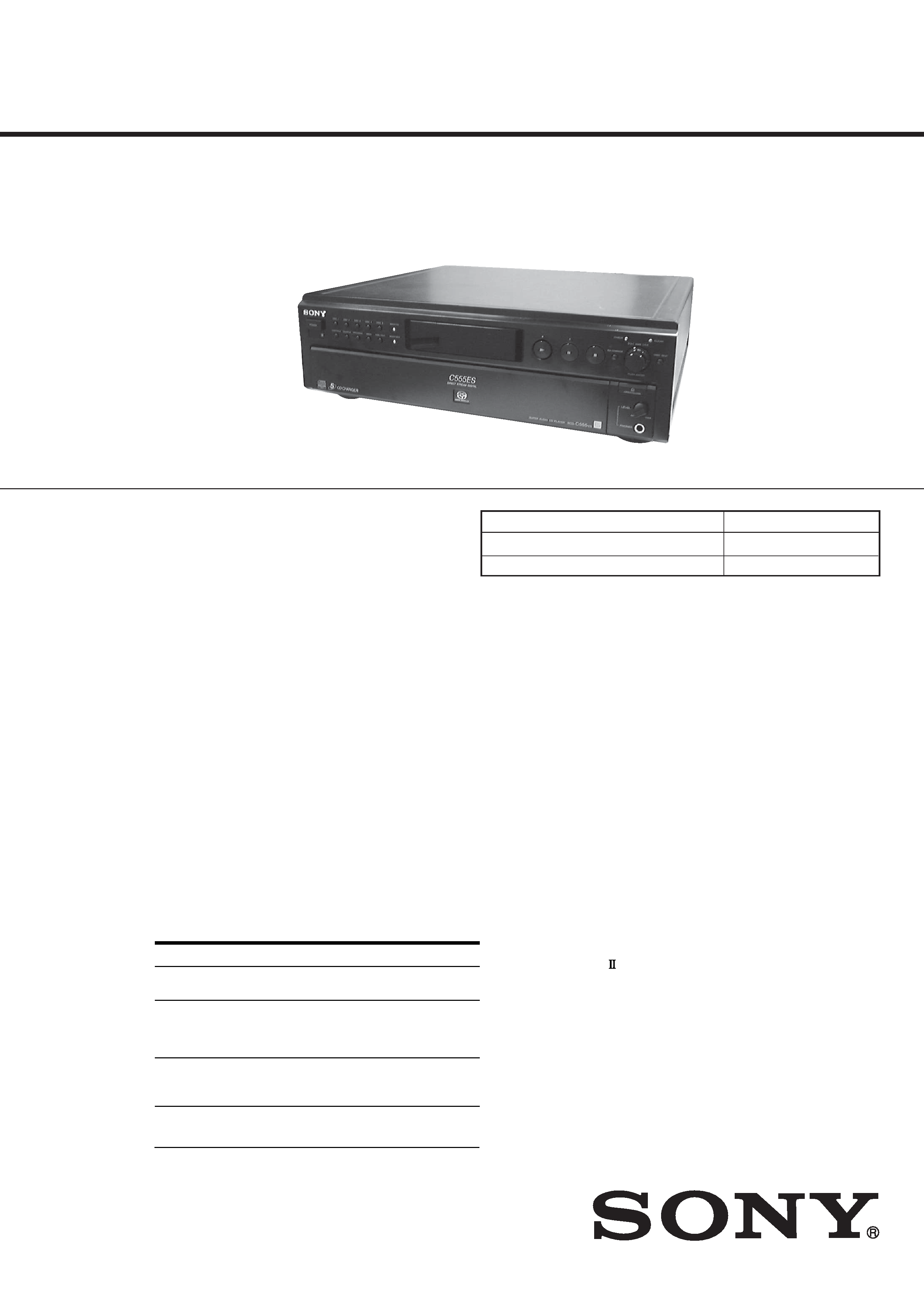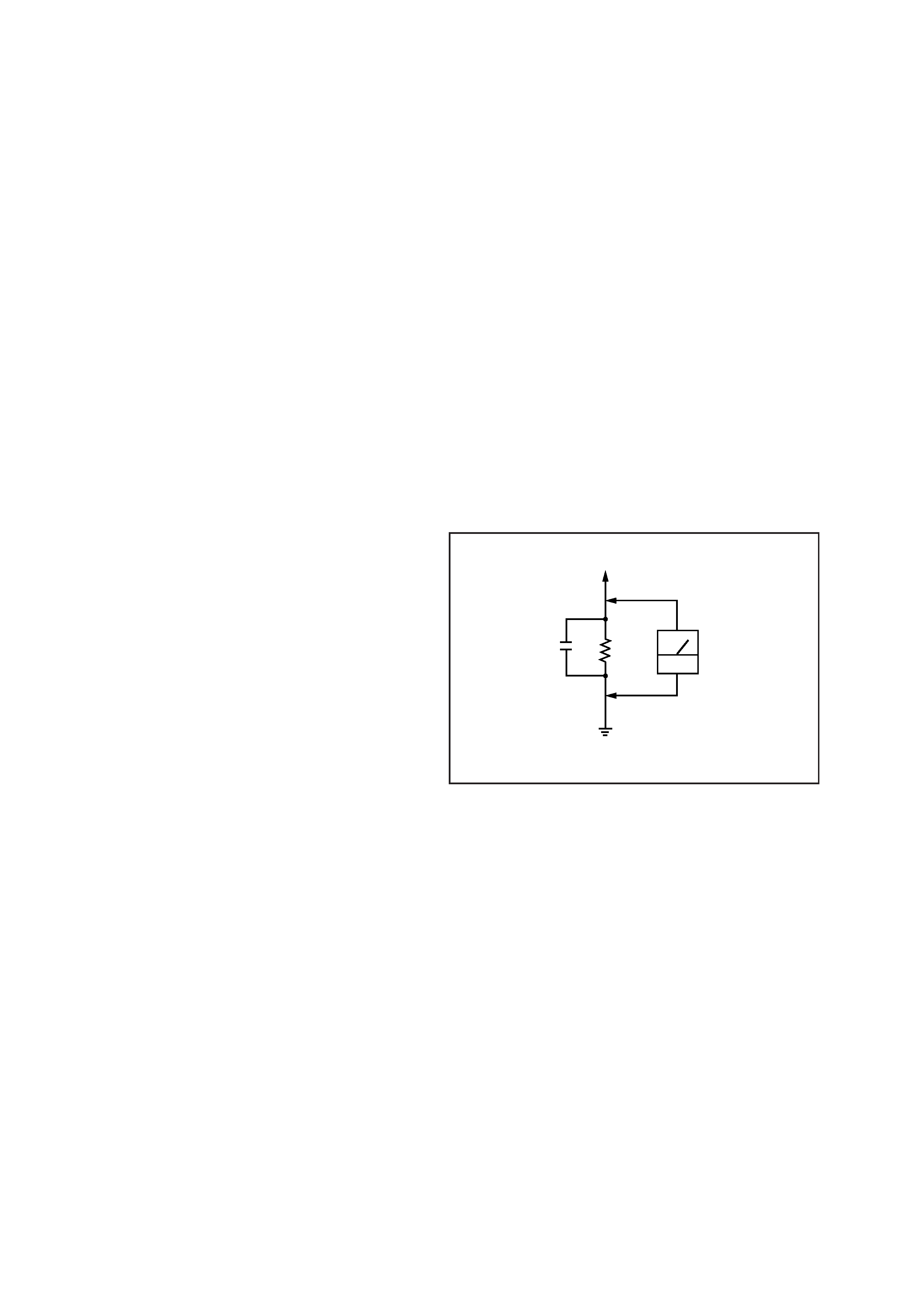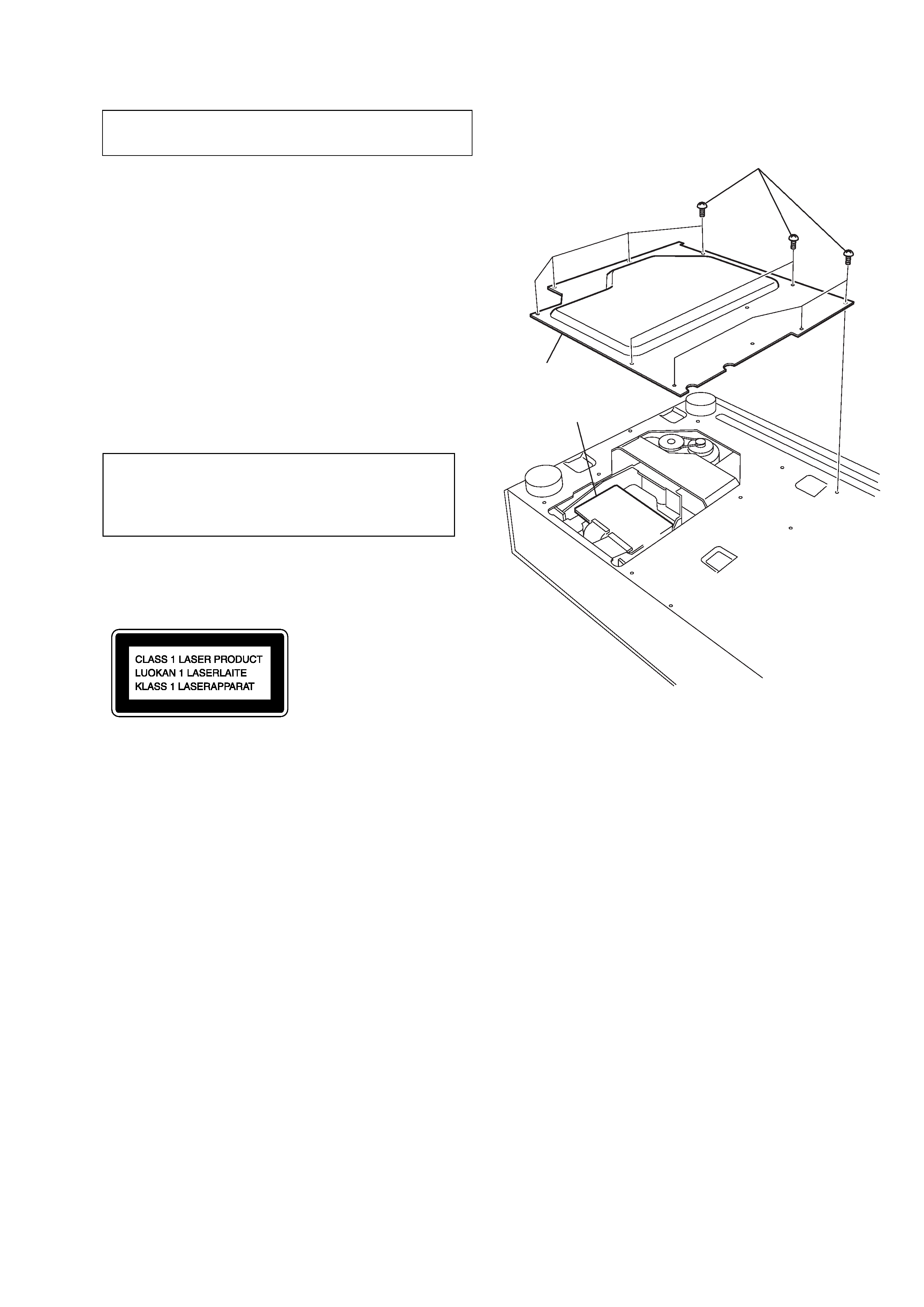
SCD-C555ES
US Model
Canadian Model
SERVICE MANUAL
SUPER AUDIO CD PLAYER
Sony Corporation
Audio Entertainment Group
General Engineering Dept.
9-873-872-11
2001C1600-1
© 2001.3
Ver 1.0 2001. 03
SPECIFICATIONS
Model Name Using Similar Mechanism
NEW
CD Mechanism Type
CDM59A
Optical Pick-up Type
KHM-230AAA/J1NP
When a super audio CD is played
Playing frequency range 2 Hz to 100 kHz
Frequency response
2 Hz to 50 kHz (3 dB)
Dynamic range
105 dB or more
Total harmonic distortion rate
0.0015 % or less
Wow and flutter
Value of measurable limit (
±0.001 %
W. PEAK) or less
When a CD is played
Frequency response
2 Hz to 20 kHz
Dynamic range
99 dB or more
Total harmonic distortion rate
0.002 % or less
Wow and flutter
Value of measurable limit (
±0.001 %
W. PEAK) or less
Output connector
General
Laser
Semiconductor laser (
= 780 nm)
Emission duration: continuous
Laser radiant power:
5.47 uW at 650 nm
*These output is the value measured at a distance of about
200mm from the objective lens surface on the optical pick-up.
Power requirements
120 V AC, 60 Hz
Power consumption
38 W
Dimensions (w/h/d)
430
× 138 × 409 mm
(17
× 5 1/2 × 16 1/8 in.)
incl. projecting parts
Mass (approx.)
11.0 kg (24 lbs 5 oz.)
Supplied accessories
Design and specifications are subject to change without notice.
Load impedance
ANALOG OUT
DIGITAL (CD)
OUT OPTICAL*
DIGITAL (CD)
OUT COAXIAL*
Phono
jacks
Jack type
2 Vrms
(at 50 kilohms)
Square
optical
output
connector
18 dBm
0.5 Vp-p
Over 10 kilohms
Light emitting
wave length:
660 nm
Output level
75 ohms
Coaxial
output
connector
(
)
*Output only the audio signals of the CD
10 mW
PHONES
Stereo
phone jack
32 ohms
· Audio connecting cord
phono jack
× 2 (Red and White) y phono jack × 2 (Red
and White) (2)
phono jack
× 1 (Black) y phono jack × 1 (Black) (2)
· Monaural (2P) mini-plug cord (1) (Connecting cord for
CONTROL A1 ) (supplied for Canadian models only)
· Remote commander (remote) RM-SC500 (1)
· R06 (size-AA) batteries (2)

2
SCD-C555ES
SAFETY-RELATED COMPONENT WARNING !!
COMPONENTS IDENTIFIED BY MARK 0 OR DOTTED LINE WITH
MARK 0 ON THE SCHEMATIC DIAGRAMS AND IN THE PARTS
LIST ARE CRITICAL TO SAFE OPERATION. REPLACE THESE
COMPONENTS WITH SONY PARTS WHOSE PART NUMBERS
APPEAR AS SHOWN IN THIS MANUAL OR IN SUPPLEMENTS
PUBLISHED BY SONY.
ATTENTION AU COMPOSANT AYANT RAPPORT
À LA SÉCURITÉ!!
LES COMPOSANTS IDENTIFIÉS PAR UNE MARQUE 0 SUR LES
DIAGRAMMES SCHÉMATIQUES ET LA LISTE DES PIÈCES SONT
CRITIQUES POUR LA SÉCURITÉ DE FONCTIONNEMENT. NE
REMPLACER CES COMPOSANTS QUE PAR DES PIÈCES SONY
DONT LES NUMÉROS SONT DONNÉS DANS CE MANUEL OU
DANS LES SUPPLÉMENTS PUBLIÉS PAR SONY.
SAFETY CHECK-OUT
After correcting the original service problem, perform the following
safety checks before releasing the set to the customer:
Check the antenna terminals, metal trim, "metallized" knobs, screws,
and all other exposed metal parts for AC leakage. Check leakage as
described below.
LEAKAGE
The AC leakage from any exposed metal part to earth Ground and
from all exposed metal parts to any exposed metal part having a
return to chassis, must not exceed 0.5 mA (500 microampers).
Leakage current can be measured by any one of three methods.
1.
A commercial leakage tester, such as the Simpson 229 or RCA
WT-540A. Follow the manufacturers' instructions to use these
instruments.
2.
A battery-operated AC milliammeter. The Data Precision 245
digital multimeter is suitable for this job.
3.
Measuring the voltage drop across a resistor by means of a
VOM or battery-operated AC voltmeter. The "limit" indication
is 0.75 V, so analog meters must have an accurate low-voltage
scale. The Simpson 250 and Sanwa SH-63Trd are examples of
a passive VOM that is suitable. Nearly all battery operated
digital multimeters that have a 2V AC range are suitable. (See
Fig. A)
Fig. A. Using an AC voltmeter to check AC leakage.
0.15
µF
To Exposed Metal
Parts on Set
1.5k
AC
voltmeter
(0.75V)
Earth Ground
TABLE OF CONTENTS
1. SERVICING NOTES (1) ............................................. 3
2. GENERAL .......................................................................... 4
3. DISASSEMBLY
3-1. Case ··············································································· 6
3-2. Front Panel Section ······················································· 6
3-3. Main Board ···································································· 7
3-4. Audio Board ·································································· 7
3-5. D-Power, I/O Board ······················································· 8
3-6. CD Mechanism Deck (CDM59-DVBU5) ····················· 8
3-7. Optical Pick-Up Block (KHM-230AAA/J1NP) ············ 9
3-8. Table Assy ····································································· 9
3-9. Tray, Sensor Board ······················································ 10
3-10. Loading Motor Board ·················································· 10
3-11. Adjusting Phase of Swing Gear and Gear (U/D) ········ 11
4. DIAGRAMS
4-1. Block Diagrams ··························································· 13
· RF/Servo Section ······················································ 13
· Main Section-1 ·························································· 14
· Main Section-2 ·························································· 15
· Audio Section ···························································· 16
· Display/Power Section ·············································· 17
4-2. Schematic Diagram
RF Section ······························· 18
4-3. Printed Wiring Board RF Section ······························ 19
4-4. Printed Wiring Board
Main Section (Side A) ··········· 20
4-5. Printed Wiring Board
Main Section (Side B) ··········· 21
4-6. Schematic Diagram
Main Section (1/5) ··················· 22
4-7. Schematic Diagram
Main Section (2/5) ··················· 23
4-8. Schematic Diagram
Main Section (3/5) ··················· 24
4-9. Schematic Diagram
Main Section (4/5) ··················· 25
4-10. Schematic Diagram
Main Section (5/5) ··················· 26
4-11. Schematic Diagram
Audio Section (1/2) ················· 27
4-12. Schematic Diagram
Audio Section (2/2) ················· 28
4-13. Schematic Diagram
D-Power Section ····················· 29
4-14. Printed Wiring Board Audio Section ························ 30
4-15. Printed Wiring Board
In Out/D-Power Section ······ 31
4-16. Schematic Diagram
In Out Section ························· 31
4-17. Schematic Diagram
Display Section ······················· 32
4-18. Printed Wiring Board
Display Section ···················· 33
4-19. Schematic Diagram
HP Section ······························ 34
4-20. Printed Wiring Board
HP Section ··························· 35
4-21. Schematic Diagram
Sensor Section ························ 36
4-22. Printed Wiring Board
Sensor Section ····················· 37
4-23. Schematic Diagram
Power Section ························· 38
4-24. Printed Wiring Board
Power Section ······················· 39
4-25. IC Block Diagrams ····················································· 40
4-26. IC Pin Function Description ······································· 44
5. SERVICING NOTES (2) ................................................ 57
6. TEST MODE ...................................................................... 58
7. EXPLODED VIEWS
7-1.Case Section ··································································· 74
7-2.Front Panel Section ························································ 75
7-3.Main Chassis Section ····················································· 76
7-4.CD Mechanism (CDM59-DVBU5) -1 Section ·············· 77
7-5.CD Mechanism (CDM59-DVBU5) -2 Section ·············· 78
8. ELECTRICAL PARTS LIST ........................................ 79

3
SCD-C555ES
CAUTION
Use of controls or adjustments or performance of procedures
other than those specified herein may result in hazardous
radiation exposure.
LASER DIODE AND FOCUS SEARCH OPERATION
CHECK
Carry out the "S curve check" in "CD section adjustment" and check
that the S curve waveform is output three times.
Notes on chip component replacement
· Never reuse a disconnected chip component.
· Notice that the minus side of a tantalum capacitor may be
damaged by heat.
Flexible Circuit Board Repairing
· Keep the temperature of soldering iron around 270°C
during repairing.
· Do not touch the soldering iron on the same conductor of the
circuit board (within 3 times).
· Be careful not to apply force on the conductor when soldering
or unsoldering.
This appliance is classified as a CLASS 1 LASER product.
The CLASS 1 LASER PRODUCT MARKING is located on the
rear exterior.
SECTION 1
SERVICING NOTES (1)
NOTES ON HANDLING THE OPTICAL PICK-UP BLOCK
OR BASE UNIT
The laser diode in the optical pick-up block may suffer electrostatic
break-down because of the potential difference generated by the
charged electrostatic load, etc. on clothing and the human body.
During repair, pay attention to electrostatic break-down and also
use the procedure in the printed matter which is included in the
repain parts.
The flexible board is easily damaged and should be handled with
care.
NOTES ON LASER DIODE EMISSION CHECK
The laser beam on this model is concentrated so as to be focused on
the disc reflective surface by the objective lens in the optical pick-
up block. Therefore, when checking the laser diode emission,
observe from more than 30 cm away from the objective lens.
The emission check enables continuous checking of the S curve.
When the bottom plate is removed, the RF board can be checked.
eleven screws
(BVTP3
× 8)
RF board
bottom plate

4
SCD-C555ES
SECTION 2
GENERAL
This section is extracted
from instruction manual.
9
EX-CHANGE button (18)
Press to replace discs while playing a disc.
0
CHECK button (23)
Press to check the programmed order.
qa
l
AMSL dial (AMS: Automatic Music Sensor)
(7, 14)
When you turn the lAMSL dial
counterclockwise by one click, you go back to the
preceding track; when you turn the lAMSL dial
clockwise by one click, you go to the succeeding track.
qs
CLEAR button (23)
Press to delete a programmed track number.
qd
DISC SKIP button (14)
Press to select the disc.
qf
PHONES LEVEL control
Adjust the headphones volume.
qg
PHONES jack
Connect the headphones.
During playback of a Multi-channel Super Audio CD,
the same signal that is output from the ANALOG
5.1CH FRONT L/R jacks is output from the PHONES
jack.
POWER
PHONES
LEVEL
MIN
MAX
AMS
PUSH ENTER
SACD
MULTI/2CH
CHECK
CLEAR
DISC SKIP
EX-CHANGE
DISC 1
CONTINUE
DISC 2
SHUFFLE
DISC 3
PROGRAM
DISC 4
MENU
DISC 5
TIME/TEXT
OPEN/CLOSE
qh
A
OPEN/CLOSE button (14)
Press to open/close the disc tray.
qj
Disc tray (14)
Press A OPEN/CLOSE to open/close the disc tray.
qk
MULTI/2CH button (with an LED) (14)
Press to select the playback area when the 2 channel +
Multi-channel Super Audio CD is loaded. When you
select the Multi-channel playback area (page 13), the
LED turns on.
ql
TIME/TEXT button (16)
Each time you press the button, the playing time of the
track, the total remaining time on the disc, or TEXT
information appears in the display.
w;
MENU button (7)
Press to enter the menu.
wa
PROGRAM button (23)
Press to select Program Play.
ws
SHUFFLE button (22)
Press to select Shuffle Play.
wd
CONTINUE button (14)
Press to resume normal play from Shuffle Play or
Program Play.
Front Panel Parts Descriptions
1
POWER switch (14)
Press to turn on/off the player.
2
Remote sensor
(4)
3
DISC 15 button (14)
Press to select the disc.
4
SACD/CD button (with an LED) (14)
Each time you press the button while the Hybrid disc
(page 13) is loaded, the layer changes between an HD
(SACD) layer (the LED turns on) and CD layer (the
LED turns off).
5
Display window (15)
Shows various information.
6
N
button (14)
Press to start play.
N
indicator
Lights up during playback.
7
X
button (14)
Press to pause play.
X
indicator
Lights up during pause.
8
x
button (14)
Press to stop play.

5
SCD-C555ES
Rear Panel Parts Descriptions
1
ANALOG 2CH OUT L/R jacks (6)
Connect to an audio component (stereo/2 channel)
using the audio connecting cord.
2
ANALOG 5.1CH OUT jacks (5)
Connect to an amplifier equipped with the 5.1CH
input jacks (Multi-channel amplifier, AV amplifier,
etc.) using the audio connecting cords.
3
DIGITAL (CD) OUT OPTICAL connector (7)
Connect to an audio component using an optical
digital cable.
4
DIGITAL (CD) OUT COAXIAL connector (7)
Connect to an audio component using the coaxial
digital cable.
R
L
5.1CH OUT
ANALOG
CONTROL
A1
OUT
DIGITAL (CD)
COAXIAL
OPTICAL
CENTER
SUB
WOOFER
SURR
FRONT
L
R
2CH OUT
5
CONTROL A1
jacks (7, 31)
Connect to a Sony audio component using the
monaural (2P) mini-plug cord.
Note
Only the audio signals of the CD can be output from the
DIGITAL (CD) OUT connectors shown in 3 and 4. Those of the
Super Audio CD cannot be output through DIGITAL (CD) OUT.
Remote Parts Descriptions
CONTINUE SHUFFLE
PLAY MODE
PROGRAM
SACD/CD
MULTI/2CH
123
456
78
10/0
9
SPACE
TIME/TEXT
CAPS
DISC
REPEAT
CHECK
AMS
CLEAR
LEVEL
>10
ENTER
MODE
DISPLAY
INPUT
NAME
DISC SKIP
+
ADJ
CD1
ABC
DEF
&!?
JKL
MNO
GHI
TUV
WXYZ
PQRS
CD2
1
CONTINUE button (14)
Press to resume normal play from Shuffle Play or
Program Play.
SHUFFLE button (22)
Press to select Shuffle Play.
PROGRAM button (23)
Press to select Program Play.
2
NAME INPUT button (29)
Press to enter the name input mode.
3
DISC/CAPS button (19, 29)
Press to select the disc.
Press to select the capital letter in name input mode.
4
Number buttons (19)
Press to enter the track numbers.
5
i
10 button (19)
Press to locate a track numbered over 10.
6
REPEAT button (21)
Press repeatedly to play all tracks or only one track on
the disc.
7
CHECK button (23)
Press to check the programmed order.
8
H
button (14)
Press to start play.
X
button (14)
Press to pause play.
x
button (14)
Press to stop play.
9
AMS ./> (AMS: Automatic Music Sensor)
buttons (19)
Press to locate a specific track.
0
m
/M buttons (20)
Press to locate a portion you want to play within a
track.
qa
DISC SKIP +/ buttons (14)
Press to select the disc.
qs
CD1/2 (COMMAND MODE) switch (7)
Select the command mode.
qd
DISPLAY MODE button (16)
Press to turn off the information.
qf
SACD/CD button (14)
Each time you press the button while the Hybrid disc
(page 13) is loaded, the layer changes between an HD
layer (the SACD/CD LED turns on) and CD layer (the
SACD/CD LED turns off).
qg
MULTI/2CH button (14)
Press to select the playback area when the 2 channel +
Multi-channel Super Audio CD is loaded. When you
select the Multi-channel playback area (page 13), the
MULTI/2CH LED turns on.
qh
TIME/TEXT/SPACE button (16, 30)
Each time you press the button, the playing time of
the track, the total remaining time on the disc, or
TEXT information appears in the display.
Press to insert a space in name input mode.
qj
ENTER button (29)
Press to decide the selection.
qk
CLEAR button (23)
Press to delete a programmed track number.
ql
LEVEL ADJ button (26)
Press to adjust the output level balance for the Multi-
channel management function (page 24).
